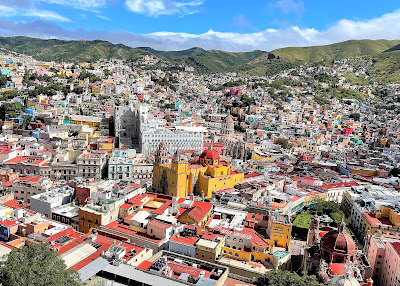When I have my San Miguel de Allende tours, we always make a day trip over to Guanajuato and our first stop is the magnificent scenic overlook with the spectacular panoramic view of colorful Guanajuato. In the 1700's Guanajuato was the largest silver producing city ever, providing over 70% of its silver to the Old World.
The Pipila monument stands about 10 meters tall and is a reminder of the War of Independence. Pipila, Juan Jose de los Reyes Martinez, was a hero and patriot born in San Miguel de Allende in 1782. In 1810, Father Miguel Hidalgo's forces were besieging the granary in Guanajuato where the Spaniards had taken refuge. It was Pipila, a miner at one time, who slapped a slab of of stone to his back to deflect the gunfire and stormed the overwhelmingly massive granary (alhonidiga) and set fire to its doors, thus opening the way for the rebels to enter and occupy the stronghold. In stone, he continues to hold the torch high, standing above the plaque promising "there are still other Alhondigas to burn."
Today the Alhondigas de Granaditas contradicts it gory past. On each of the four corners of the building, you will find large hooks set into the wall. Each hook held a cage with the head of the heroes (Father Miguel Hidalgo, Juan Aldama, General Ignacio Allende and Mariano Jimenez) until 1821 when the Spaniards left Mexico for Spain for good. Today the Alhondiga is a state and federal museum.A view of town with the Guanajuato Mountains in the back and the prominent Basilica de Nuestra Senora de Guanajuato dead center and the state University behind it.
I love all the pedestrian streets in Guanajuato. So welcoming.
The interior of the Basilica with 15 huge crystal chandeliers adorning the vaulted ceiling. The Virgin at the back of the church is made of wood and was given to the city by Felipe II in 1557. It has been venerated in Spain since the year 714 and so it is the oldest religious figure in Mexico.
El jardin de la Union is the main plaza is unique. Because of the lack of flat land conducive to the typical broad, square Mexican plaza, the plaza is a rather unusual shape and it has the nickname, "a wedge of cheese". Almost entirely covered by a thick canopy of Laurel trees, there is a handsome gazebo in the middle.









No comments:
Post a Comment